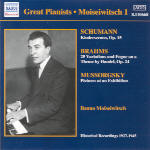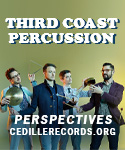Benno Moiseiwitsch’s 1930 recording of Schumann’s Kinderszenen abounds in fingerprints of Romantic pianism: long, introspective legato lines that taper into the sunset even at quick tempos (the “Am Camin” and “Früchtenmachen” movements, for instance); rolled chords and sometimes overwrought inner counterpoints (the opening and closing pieces, plus much of the left hand work in “Träumerei”); and redistribution of the text in different octaves (the ending of “Hasche-Mann”). You tend to notice the pianist more than the composition, whereas the myriad liberties throughout Alfred Cortot’s 78-era Kinderszenens seem to connect more directly to the music’s lyrical spirit.
Similar inner-voice action and smoldering cantilenas in the pianist’s 1930 Brahms Handel Variations come off better here than in his 1953 remake, though I find the headlong, cumulative approach of Egon Petri or Solomon more stylistically apt. On the other hand, Moiseiwitsch plays up the burly phrase displacements against the meter in the same composer’s E-flat Rhapsody Op. 119 No. 4 and shapes the little C major Intermezzo (Op. 199 No. 3) in an extroverted, almost brusque manner quite different from Myra Hess’ limpid grace.
The aforementioned characteristics I take issue with in Moiseiwitsch’s Kinderszenen also apply to much of his work in Mussorgsky’s Pictures. His rubatos and ritards tend to soften and sectionalize the inherent drama within movements such as The Old Castle, Samuel Goldenberg and Schmuyle, and the Hut on Fowl’s Legs. Bydlo’s rough, churning edges also are unduly rounded off, and the final pages of The Great Gate at Kiev fail to build and truly resonate. Nalen Anthoni’s notes mention the pianist’s cuts in the latter movement as well as in The Old Castle. Astute listeners also will notice oddball octave transpositions, as in the middle section of the Ballet of the Unhatched Chicks.
Ward Marston’s transfers live up to his usual clean, honest standard. I do, however, prefer Seth Winner’s richer, more pellucid-sounding equalization of the Brahms Handel Variations on Pearl 9135, although Winner’s transfer was effected from inferior pressings in comparison with Marston’s excellent shellac sources. One caveat: my first copy of the Naxos disc contained a 10-second gap of silence in the middle of Track 52 (from 0:59 to 1:09). This defect has been corrected, but you may want to check your copy anyway.
































